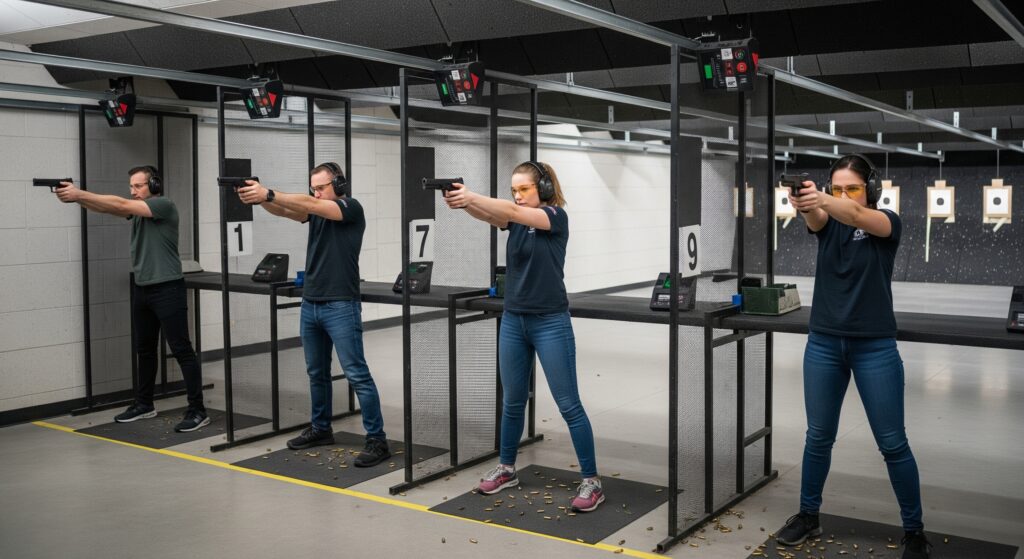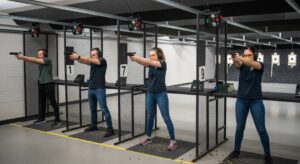Mastering Firearms Training: A Beginner’s Guide to Essential Techniques and Safety
Starting your journey into firearms training might seem overwhelming, with all the jargon and safety measures to consider. But don’t worry—our structured approach will turn your uncertainty into confidence. This guide is your roadmap to mastering universal safety principles, foundational shooting techniques, smart firearm selection, effective dry-fire practice, live-fire readiness, recoil management, legal compliance, and self-defense basics. With Phylax Global’s veteran-instructor model and scenario-based training, you’ll evolve from mastering safe handling to exploring advanced concealed-carry opportunities.
Essential Firearms Safety Rules for Every Beginner
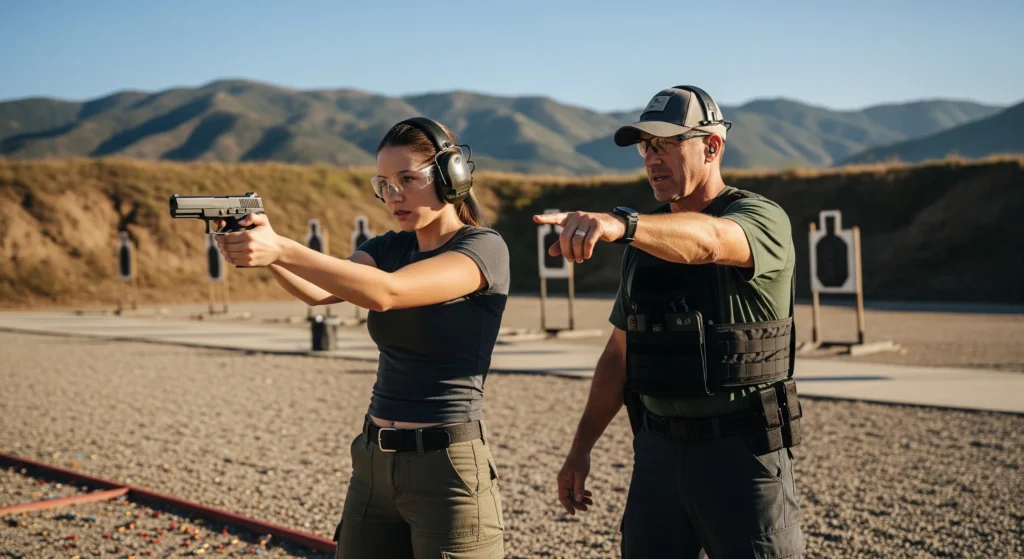
Safety is the cornerstone for any new shooter. Embracing these foundational guidelines nurtures a culture of caution that influences every aspect of firearms training and self-defense.
The Four Universal Gun Safety Rules
These four rules are the foundation of responsible gun handling, crafted to prevent negligent discharges and boost situational awareness.
- Treat Every Gun as Loaded—To maintain constant vigilance, always assume a firearm is loaded, even if you think it’s not.
- Never Point at Anything You Do Not Intend to Shoot – Keep the muzzle directed in a safe direction to avoid accidents.
- Keep Your Finger Off the Trigger Until Ready to Fire – Keep your finger indexed outside the trigger guard to prevent accidental discharge.
- Be Sure of Your Target and Backstop – Confirm your target and what lies beyond to ensure safe engagement.
Following these principles significantly reduces risk and lays the groundwork for precise handling habits.
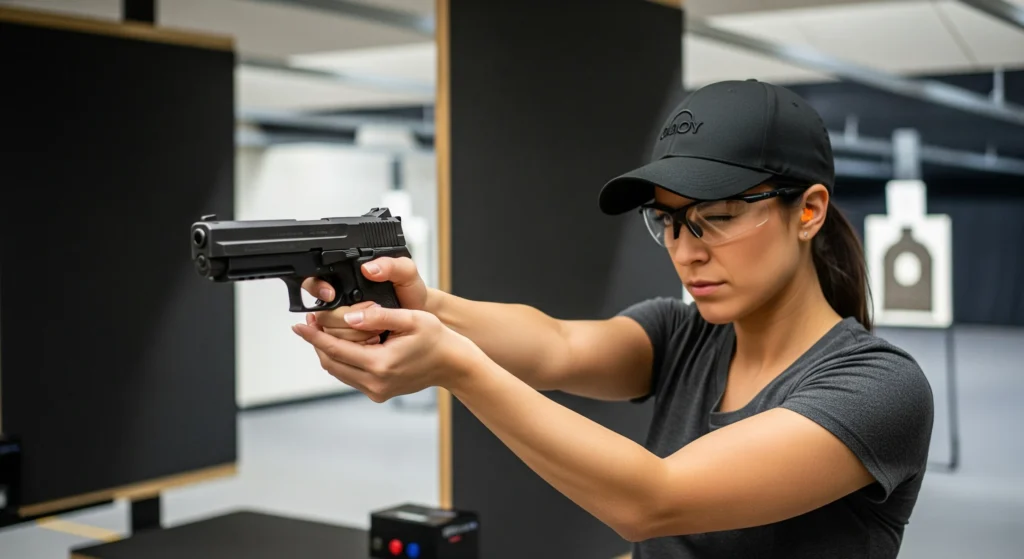
Preventing Accidents with Proper Firearm Safety
Implementing proper firearm safety protocols is crucial for preventing accidents and ensuring responsible gun ownership. These protocols include treating every gun as if it’s loaded, never pointing a firearm at anything you don’t intend to shoot, keeping your finger off the trigger until ready to fire, and being certain of your target and what lies beyond it.
National ShootingSports Foundation, “Firearms Safety Rules” (2024)
This source underscores the importance of foundational safety rules for all firearm users, as highlighted in this guide.
Practicing Safe Firearm Handling and Storage
Safe handling and secure storage are vital to prevent unauthorized access and promote lasting responsibility. Store firearms unloaded in a locked safe or cabinet, use trigger-lock devices, and separate ammunition. Regularly check the chamber and magazine before storage.
- Inspect mechanical safety and magazine-release function monthly.
- Clearly label storage containers to avoid mix-ups.
- Use tamper-proof cases for transportation.
These habits build trust in your handling process, naturally leading to heightened personal safety awareness.
The Importance of Personal Safety Awareness in Firearms Training
Personal safety awareness involves environmental scanning and threat recognition, complementing mechanical safety rules. Recognizing cover, identifying potential hazards, and maintaining muzzle awareness form a mental framework that prevents accidents and enhances decision-making under stress. With improved situational perception, learners transition smoothly from static drills to dynamic scenario-based exercises.
Core Shooting Techniques for Beginners
Mastering foundational shooting techniques is key to developing marksmanship and confidence. Beginners build muscle memory and precision that scale with advanced training by focusing on grip, stance, sight alignment, and trigger control.
Achieving the Proper Grip for Handgun Control
A proper handgun grip is essential for managing recoil and consistently forming sight pictures. Anchor the firearm firmly between your strong and support hands, positioning your strong-hand web high on the backstrap, wrapping fingers snugly, and placing the support hand forward to form a unified platform. This grip maximizes control and directly improves shot grouping.
The Correct Stance for Accuracy and Stability
The correct stance aligns body weight and kinetic energy to manage recoil and maintain balance. Use the isosceles stance by facing the target squarely with feet shoulder-width apart, knees slightly bent, and arms extended evenly. This posture enhances stability, promotes faster sight reacquisition, and reduces shooter fatigue during extended sessions.
Improving Shooting Precision with Sight Alignment and Sight Picture
Sight alignment, leveling front and rear sights, and sight picture place aligned sights over the target, establishing a direct visual link between the shooter and the point of impact. Shooters achieve repeatable precision and faster target transitions in dynamic drills by focusing on the front sight while maintaining rear-sight equal spacing.
Best Practices for Smooth Trigger Control
Smooth trigger control isolates finger movement from grip tension to prevent jerking or flinching. Apply constant, gradual pressure straight to the rear until the shot breaks, then follow through without immediately releasing pressure. Effective drills include dry-fire trigger-press repetitions and timed resets to engrain consistent pull mechanics.
Choosing Your First Firearm: Handgun, Rifle, or Shotgun
Selecting the right firearm type balances personal comfort, intended use, and skill development needs. Evaluating ergonomics, recoil, accuracy, and ammunition cost ensures a successful first purchase and training experience.
Factors to Consider When Selecting a Firearm Type
Consider factors such as ergonomics, recoil impulse, modularity, and maintenance complexity to match your physique and training goals. Weight distribution, grip circumference, sight options, and caliber availability influence comfort and progression. Testing multiple platforms at a range clarifies personal preferences before committing.
The Impact of Caliber Choice on Beginner Shooters
Caliber selection affects recoil management, ammunition cost, and terminal performance. Lower-recoil calibers like 9mm or .22 LR foster faster skill acquisition and reduced muzzle flip, while higher-power rounds require advanced grip and stance proficiency. A balanced caliber choice accelerates learning by minimizing physical strain.
Pros and Cons of Handguns vs. Rifles vs. Shotguns for New Shooters
Before investing, compare key attributes and training trajectories:
| Firearm Type | Attribute | Value |
|---|---|---|
| Handgun | Portability | Compact size aids carry and indoor practice |
| Rifle | Accuracy | Longer sight radius improves precision |
| Shotgun | Stopping Power | Wide shot spread suits close-range defense |
Handguns are versatile for self-defense and concealed carry, rifles build foundational marksmanship over distance, and shotguns offer immediate stopping power, each with size, cost, and recoil trade-offs.
Enhancing Skills with Dry Fire Training
Dry-fire training develops core mechanics and visual habits without range fees or ammunition constraints. Shooters reinforce motor patterns and sight alignment by practicing safe, unloaded drills at home for quicker live-fire progression.
Benefits of Dry Fire Training
Dry-fire practice is a safe and effective method for improving shooting skills without live ammunition. It helps develop muscle memory, refine trigger control, and enhance sight alignment. This practice is particularly beneficial for beginners as it allows them to focus on the fundamentals without the added complexity of recoil.
Department of the Army, “Marksmanship Training” (2023)
This citation supports the article’s emphasis on the value of dry-fire practice as a key component of firearms training for beginners.
Safety and Effectiveness of Dry Fire Practice for New Shooters
Yes, dry-fire practice is both safe and effective when performed with an unloaded firearm in a controlled environment. It strengthens grip consistency, trigger control, and sight picture awareness without recoil, accelerating live-fire accuracy improvements by building reliable muscle memory.
Top Dry Fire Drills for Beginners
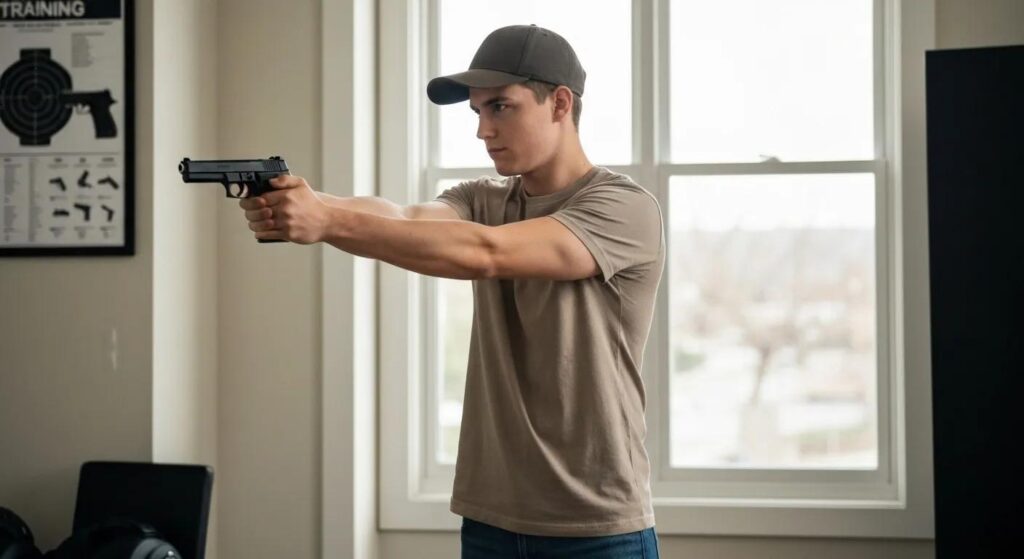
The most impactful beginner dry-fire drills focus on fundamental skills:
- Wall Drill – Point at a blank wall to practice trigger press while monitoring front sight alignment.
- Coin Drill – Balance a coin on the slide, then press the trigger without dropping it to refine smooth trigger movement.
- Sight Focus Drill – Rapidly shift focus between front sight and target outlines to reinforce a clear sight picture.
Preparing for Live Fire After Dry Fire Practice
Transitioning to live fire requires a safety check and gradual cadence introduction. Begin with single-shot drills at close range, reconciling sight alignment and trigger rhythm under recoil. Increase round counts incrementally, focusing on quality over quantity to maintain the mechanical precision established during dry fire.
What to Expect at Your First Live Fire Range Session
A structured range session builds confidence and group-shooting proficiency under professional supervision. Understanding live-fire protocols and etiquette optimizes learning and fosters a respectful training environment.
Essential Live Fire Range Safety Rules
Live fire amplifies risk, so enforcing safety protocols is critical. Keep the muzzle pointed downrange, keep finger off the trigger until aiming, observe firing line commands, and wear eye and ear protection. Adhering to range officer instructions prevents unsafe conditions and promotes positive training experiences.
Building Accuracy and Confidence with Live Fire Drills
Live fire drills such as controlled pairs, draw-and-fire sequences, and timed magazine changes layer speed on accuracy. Repeating standardized drills under pressure cements marksmanship fundamentals and builds mental resilience, leading to measurable confidence gains with each session.
Proper Range Etiquette for Beginner Shooters
Proper range etiquette ensures a harmonious environment. Respect shooting lanes, announce malfunctions, retrieve brass with minimal disturbance, and maintain clear communication with instructors and peers. Courteous behavior enhances collective safety and learning outcomes.
Managing Firearm Recoil and Developing a Responsible Mindset
Managing recoil and cultivating psychological discipline underpin sustainable progress and safe self-defense capabilities.
Effective Recoil Control Techniques for New Shooters
Effective recoil control balances grip tension, stance absorption, and follow-through. Lean slightly forward at the hips, grip firmly without tension spikes, and allow the firearm to recoil naturally before re-acquiring sights. Consistent practice of mechanics in slow-fire and rapid-fire drills reduces perceived recoil and improves shot-to-shot recovery.
The Importance of a Responsible Firearms Mindset
A responsible mindset bridges mechanical skill and ethical use by embedding respect for the power of firearms. Emphasizing situational judgment, legal awareness, and use-of-force principles cultivates disciplined decision-making—a prerequisite for advanced tactical and concealed-carry training.
Understanding Legal Requirements and Training Certifications
Navigating legal frameworks and certification processes ensures compliance and unlocks advanced training credentials.
State-Specific Firearm Training and Ownership Laws
State laws vary on background checks, waiting periods, and mandatory training courses. Research local statutes regarding required safety classes, storage mandates, and permit prerequisites to ensure lawful ownership. Staying informed on legislative changes prevents unintentional violations.
Firearm Safety Certificates and Licenses for Beginners
Firearm safety certificates validate completion of approved training, covering legal regulations, safety practices, and basic marksmanship. Licenses such as concealed-carry permits often require additional coursework and live-fire qualification tests. Securing these credentials opens opportunities for advanced courses.
Finding Certified Firearms Instructors and Courses
Seek instructors affiliated with recognized organizations and backed by combat or law-enforcement experience. Review credentials, student feedback, and curriculum scope. Explore Phylax Global’s network of veteran-led classes and professional seminars for in-person or virtual options. For upcoming dates and specialized events, visit our tactical training events.
Phylax Global Firearms Training Programs for Beginners
Phylax Global combines veteran-instructor guidance with scenario-based drills to accelerate foundational skill development. Our beginner segment offers progressive modules that integrate safety, marksmanship, and defensive tactics.
What Sets Phylax Global’s Training Apart for New Shooters?
Phylax Global’s curriculum merges battle-tested methodologies with personalized coaching, ensuring each trainee masters safety fundamentals and dynamic engagement. Real-world scenario simulations and small group ratios foster rapid skill acquisition and lasting confidence.
Beginner Courses Offered by Phylax Global
| Course Name | Focus Area | Duration |
|---|---|---|
| Basic Pistol Foundations | Safety, Grip & Trigger Control | 1 day (8 hours) |
| Intro to Defensive Rifle | Carbine Handling & Accuracy | 2 days (16 hours) |
| Shotgun Essentials | Close-Range Tactics | 1 day (8 hours) |
Enrolling and Preparing for Your firearms trainings you can find more information on our: Phylax Global Tactical Training Classes. Upon registration, review the pre-course safety checklist, arrange required equipment, and complete the online orientation to maximize in-class time.
Fundamental Self-Defense Principles for Beginners
Self-defense with a firearm extends beyond marksmanship, including threat detection, de-escalation techniques, and responsible force application.
Enhancing Firearm Self-Defense with Situational Awareness
Situational awareness forms the cognitive backdrop for self-defense by continuously assessing surroundings, detecting anomalies, and identifying escape routes. This proactive mindset prevents surprises and informs whether engagement is necessary.
Basic Defensive Shooting Techniques for Beginners
Basic defensive techniques emphasize rapid presentation, controlled first shot under stress, and immediate cover engagement. Techniques such as the Weaver and Isosceles stances in tactical contexts equip beginners to deliver accurate defensive shots while minimizing exposure.
Next Steps After Mastering Beginner Firearms Training
After solidifying foundational skills, structured progression into advanced tactical and concealed-carry courses positions shooters for real-world scenarios and specialized roles.
Progressing to Tactical and Concealed Carry Training
Transition is achieved when 90% accuracy is consistent at 7 yards, and safety protocols are second nature. Tactical and concealed-carry modules build on these metrics to introduce movement drills, retention techniques, and legal considerations for on-duty or personal defense roles.
Building on Basic Firearms Skills with Advanced Courses
Advanced courses layer dynamic scenarios, stress inoculation, and multi-target engagement to challenge decision-making under pressure. Integrating low-light shooting, vehicle-borne tactics, and team-based operations expands competencies for military, law-enforcement, or high-net-worth personal protection assignments.
Moving through these structured stages equips beginners with the knowledge, skills, and mindset to train safely and effectively. By adhering to universal safety rules, establishing core shooting fundamentals, choosing the appropriate firearm, practicing dry-fire drills, mastering live-fire sessions, managing recoil, understanding legal requirements, and embracing self-defense principles, new shooters reach readiness for advanced tactical and concealed-carry training. Phylax Global’s veteran-driven courses ensure that expert instruction and scenario-based applications support each step, empowering determined individuals to master firearms training and responsible self-defense.

